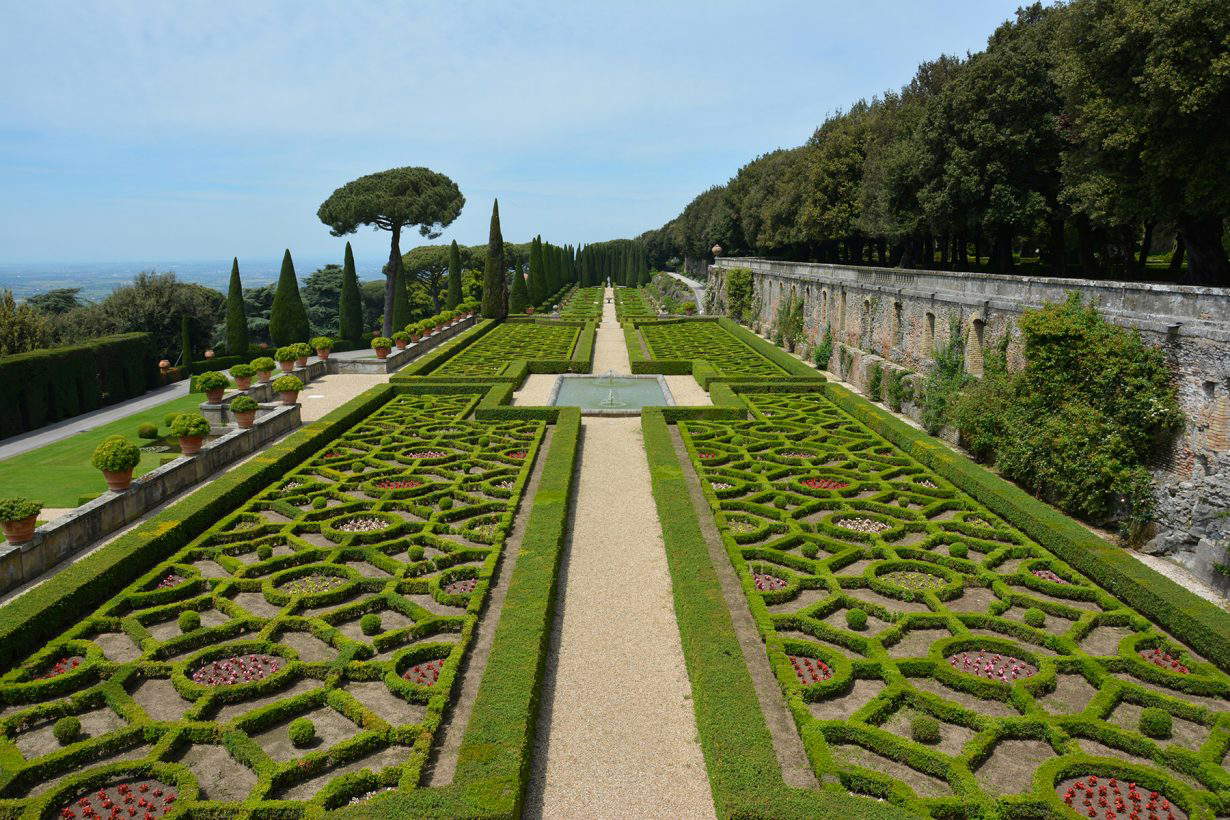A labyrinth that is not a labyrinth: the garden of Villa Barberini at Castel Gandolfo
A labyrinth adorns the garden of one of the most beautiful palaces in the Castelli Romani: this is the labyrinth of Villa Barberini, located in Castel Gandolfo, among the Alban Hills. Villa Barberini is among the most interesting pontifical villas in Castel Gandolfo, the papal residences that dot Lake Albano and are included in the extraterritorial areas in Italy of the Holy See, to which they were granted in 1929 under the Lateran Pacts. Villa Barberini stands where Emperor Domitian’s villa once stood: in 1631 Taddeo Barberini, nephew of Maffeo Barberini (who ascended to the papal throne in 1623 with the name Urban VIII), purchased a residence that had belonged to Monsignor Scipione Visconti and had incorporated the little that remained of the ancient imperial villa. Taddeo Barberini ordered the rearrangement of the villa, and by 1635 the building could finally be said to be completed.
The palace served as a summer residence and a place of representation for the Barberini family, who wanted a space worthy of their social and political position. For this reason, too, the entire surrounding area was transformed into a wonderful garden , which even today remains the main attraction of Villa Barberini for those who visit it (in fact, the palace’s gardens can be visited by purchasing a ticket online from the Vatican Museums, which manage it). The garden we see today, however, is more recent: during the nineteenth century, in fact, Villa Barberini experienced a period of degradation, and it was only after the stipulation of the Lateran Pacts that the park was rearranged, including the inclusion of gardens designed from scratch. Work was also promoted to connect the palace to other papal residences: “provision was made,” writes the scholar Saverio Petrillo, “to carry out important consolidation and renovation works on the papal palace to adapt it to the new requirements and to make the connections between the three villas (Giardino del Moro, Villa Cybo and Villa Barberini) by means of the flyover linking the Barberini tenimento with Villa Cybo and then with the loggia that, from the latter’latter, leads to the palace above the public street, on the arch of the ancient Roman gate.”




And in a garden as vast as that of Villa Barberini, a labyrinth could not be missing, even if it is a very peculiar maze, because it is nothing more than a piece of Italian garden that takes up the forms of a labyrinth. This style of gardening, which originated in the Renaissance, is characterized by its symmetry, geometric distribution of spaces, manicured hedges, and the presence of fountains, water features, and classical statues. The labyrinth, located at the rear of the palace, overlooking the lake, is a kind of geometric installation of boxwood(Buxus sempervirens) hedges carefully pruned to create an intricate path, but where there is actually neither an entrance nor a center. It should be thought of as a kind of quadrilateral, divided into four sectors surrounding a central fountain (which is reached, however, by four pathways that arise out of the green space), with hedges that resemble the meanders of a labyrinth.
One could therefore say that there are actually four labyrinths. And they constitute a setting, rather than a true maze, a reprise of geometric motifs also found elsewhere in the park, a kind of ornamentation that departs from the idea of the classic labyrinth with an entrance (or several entrances), a center, and an exit. A maze, in short, that we can think of as designed to delight guests, rather than to amuse or fascinate them. The hedges, just over a meter high, form a series of narrow corridors and unexpected turns that create ingenious paths. The labyrinth also probably dates back to the twentieth-century rearrangement, when architect Giovanni Momo produced designs for the recovered garden.
The palace and its gardens, as anticipated, are open to the public, so visitors can appreciate all the beauty and history of this unique place. But not only that: they can also compare this labyrinth with that of another palace that once belonged to the popes, the Quirinale. There, too, in the gardens, there is in fact a labyrinth, which unlike that of Villa Barberini is walkable, has a center, and was designed with the aim of inviting guests of the palace to walk it. A passion, that for labyrinths, which evidently must have been particularly widespread in the papal court.
 |
| A labyrinth that is not a labyrinth: the garden of Villa Barberini at Castel Gandolfo |
Warning: the translation into English of the original Italian article was created using automatic tools. We undertake to review all articles, but we do not guarantee the total absence of inaccuracies in the translation due to the program. You can find the original by clicking on the ITA button. If you find any mistake,please contact us.


























